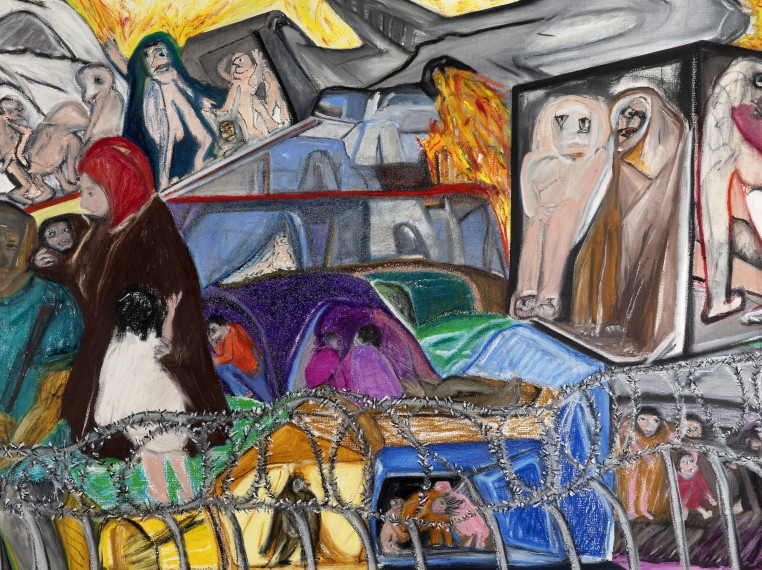
Photo: Timothy Doyon, Courtesy of Ortuzar Projects
Photo: Timothy Doyon, Courtesy of Ortuzar Projects
Photo: Timothy Doyon, Courtesy of Ortuzar Projects
Photo: Timothy Doyon, Courtesy of Ortuzar Projects
Photo: Timothy Doyon, Courtesy of Ortuzar Projects
Photo: Timothy Doyon, Courtesy of Ortuzar Projects
Photo: Timothy Doyon, Courtesy of Ortuzar Projects
Photo: Timothy Doyon, Courtesy of Ortuzar Projects
Photo: Timothy Doyon, Courtesy of Ortuzar Projects
Photo: Timothy Doyon, Courtesy of Ortuzar Projects
JACQUELINE DE JONG: BORDER-LINE
November 11, 2021 – January 8, 2022
Opening Reception: November 10, 2021, 6-8PM
Ortuzar Projects is pleased to present new paintings and works on paper by Dutch artist Jacqueline de Jong, her first solo show in New York in over fifty years. All made since the beginning of the pandemic lockdown, the works in Border-Line take as their subject matter the refugee crises that have unfolded in the era of mass-globalization. The series echoes the formal intensity of her earliest work from the 1960s: violently expressive, often grotesque paintings that were inflected by her own experience of displacement within Europe during World War II. In the intervening decades, the artist’s wide-ranging painterly strategies have refused interpretation, giving form to the cruelty, banality, humor, eroticism, and even joie de vivre of the human condition within a world in conflict.
Often re-approaching her own earlier dérives through canonical styles—from Abstract Expressionism to Art Brut, feminist Pop, narrative figuration, and Postmodernism—de Jong’s eclectic oeuvre reveals a singular voice characterized less by formal consistency than by a strong conviction towards the revolutionary in both politics and art. Best known as one of the few female members of the Situationist International, de Jong’s unwavering dedication to painting resulted in her expulsion from the increasingly theoretical group, after which she founded and designed the influential journal The Situationist Times.
De Jong’s painting has addressed the alienated and erotic lives of astronauts (1966–67); her own artistic itinerancy through diaristic paintings encased in frames resembling valises (1971–73); and the sexual violence inherent to the noir genre (1980–81). Her persistent and prolific production counters her enduring preoccupation with human suffering. Since the early 1990s her work has often focused on global conflict, such as the collective mass-media experience of the First Gulf War in her 1991 series “Megaliths," or in drawing connections between World War I and the ongoing Syrian Civil War in “WAR 1914–18” (2013–14).
In Moria (08.09.20) (Border Line), 2021, flames and disjointed structural remains fill the upper portion of the canvas. Huddled figures rendered in sooty greys haunt the distant middle ground, alluding to the fire in August 2020 that destroyed what had been the largest refugee camp in Europe on the island of Lesbos in the Aegean Sea. At the center of the painting is a crunched and fleshy figure clutching its throat, as if unable to breathe. (Aan de ketting) – Enchaîné Lesbos (Border Line), 2020, refers to the claustrophobic Sea-Watch vessel that intercepts migrants as they cross the Mediterranean, shown underneath a monstrous full moon; whereas the shipboard procession in Ocean Viking (Border Line), 2021, depicts apostolic figures shrouded under the thin membrane of space blankets, some rendered in gold leaf.
Compressing geographies and historical time, in present-day scenes from Moria and Idlib, Syria (where temporary refugee camps have solidified into urban wastelands), the Canary Islands, Colombia and Venezuela, de Jong’s jarring scale shifts, fractured compositions, and thick lines of saturated oil stick seem to express the futility of national borders. Mixing naturalistic forms with skeletal, animalistic, or entirely non-representational figures, de Jong’s works invoke the trauma of dispossession, and the political powerlessness felt by the viewer-as-voyeur.
Jacqueline de Jong (b. 1939, Hengelo, Netherlands) was recently the subject of a major retrospective at WIELS Centre d’Art Contemporain, Brussels (2021), which is currently on view at MOSTYN, Wales and will travel to Kunstmuseum Ravensburg, Germany in 2022. Solo institutional exhibitions include Stedelijk Museum, Amsterdam (2019); Musée Les Abattoirs, Toulouse (2018); Malmö Konsthall (2018) and the Beinecke Library of Rare Books and Manuscripts, Yale University (2011), which acquired her archive, the Jacqueline de Jong Papers. Her work has been featured in the contextual surveys Strategic Vandalism: The Legacy of Asger Jorn’s Modification Paintings, Petzel, New York (2019); Asger Jorn & Jacqueline de Jong: Case of the Ascetic Satyr, Galerie Clemens Thimme, Karlsruhe (2016); and The Avant-Garde Won’t Give Up: Cobra and Its Legacy, Blum & Poe, Los Angeles (2015). She is the recipient of an Outstanding Merit Award (2019), administered by the French Ministry for Culture and the AWARE Prize for Women Artists. Her work is in the permanent collections of the Musée National d'Art Moderne, Centre George Pompidou, Paris; Stedelijk Museum, Amsterdam; Moderna Museet, Stockholm; Musée les Abattoirs, Toulouse; Cobra Museum for Modern Art, Amstelveen; Frans Hals Museum, Haarlem; Museum Arnhem, Arnhem; Museum Boijmans van Beuningen, Rotterdam; Museum Jorn, Silkeborg; Henie Onstad Kunstsenter, Oslo; MONA Tasmania; Kunstmuseum Göteborg; Lenbachhaus, Munich; MCCA Toronto, and others.
Jacqueline de Jong, African refugees (Gran-Canaria) (Border Line), 2020-2021
Jacqueline de Jong, Locked in and Out, 2021
Jacqueline de Jong, (Aan de ketting) – Enchaîné Lesbos (Border Line), 2020
Jacqueline de Jong, Ocean Viking (Border Line), 2021
Jacqueline de Jong, Idlib in mud with dead infant (Border Line), 2021
Jacqueline de Jong, Devils Moregate, 2021
Jacqueline de Jong, Idlib (Moria), Refugee Camp (Border Line), 2020
Jacqueline de Jong, Refugees (Bogotá/Venezuela) (Border Line), 2020
Jacqueline de Jong, Sous Terrain, 2021
Jacqueline de Jong, La Méditerranée, 2020
Jacqueline de Jong, Confinement (Border Line), 2020
Jacqueline de Jong, Moria (Idlib) Refugee Camp (Border Line), 2020
